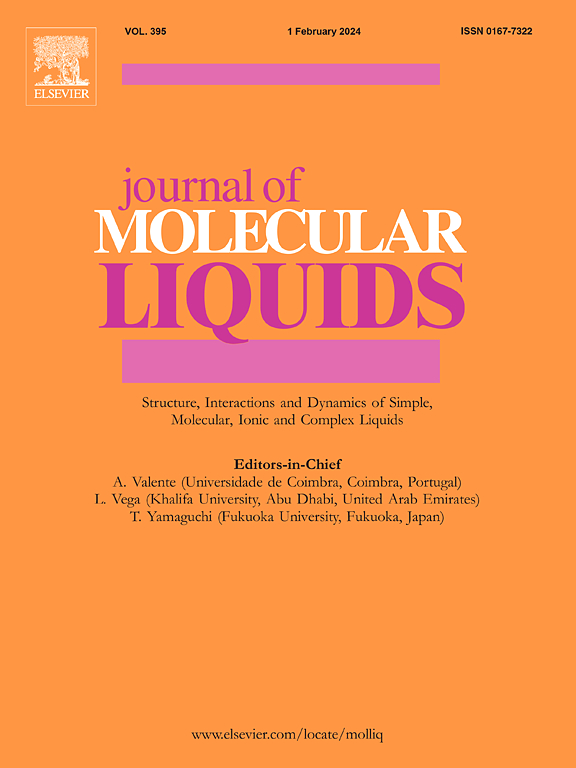电化学与DTF联合研究黑荆提取物在盐酸溶液中作为低碳钢的绿色缓蚀剂
IF 5.3
2区 化学
Q2 CHEMISTRY, PHYSICAL
引用次数: 0
摘要
本文研究了Elaeagnus angustifolia (EA提取物)果实水提取物在1 M HCl溶液中对低碳钢(MS)的缓蚀性能。该研究评估了不同浓度的EA提取物作为环保型缓蚀剂的有效性。所采用的方法包括重量测量、电化学阻抗谱(EIS)、动电位极化(PDP)、扫描电子显微镜(SEM)和密度泛函理论(DFT)计算。结果表明,增加EA提取物的浓度可以提高抑菌效果。在100 mg/L时,EA提取物的抑制率分别为82.4%(重量法)、92.8% (EIS法)和86.9% (PDP法),具有较强的保护作用。此外,数据最符合Langmuir吸附等温线模型。量子化学计算进一步证实了EA萃取物有机分子在表面的吸附,有助于解释其缓蚀机理。本文章由计算机程序翻译,如有差异,请以英文原文为准。
Combined Electrochemical and DTF Approaches to Elaeagnus Angustifolia Extract as a Green Corrosion Inhibitor for Mild Steel in HCl Solution
This study examines the corrosion inhibition properties of water extracts from Elaeagnus angustifolia (EA extract) fruit on mild steel (MS) in a 1 M HCl solution. The study assesses the effectiveness of different concentrations of EA extract as an eco-friendly corrosion inhibitor. The methodology employed includes gravimetric measurements, electrochemical impedance spectroscopy (EIS), potentiodynamic polarization (PDP), scanning electron microscopy (SEM), and density functional theory (DFT) calculations. The results show that increasing the concentration of the EA extract enhances the inhibition efficiency. At 100 mg/L, EA extract achieved inhibition efficiencies of 82.4 % (gravimetric), 92.8 % (EIS), and 86.9 % (PDP), indicating strong protective behavior. Additionally, the data best aligns with the Langmuir adsorption isotherm model. Quantum chemical calculations further confirm the adsorption of EA extract organic molecules on the surface, helping to explain the corrosion inhibition mechanism.
求助全文
通过发布文献求助,成功后即可免费获取论文全文。
去求助
来源期刊

Journal of Molecular Liquids
化学-物理:原子、分子和化学物理
CiteScore
10.30
自引率
16.70%
发文量
2597
审稿时长
78 days
期刊介绍:
The journal includes papers in the following areas:
– Simple organic liquids and mixtures
– Ionic liquids
– Surfactant solutions (including micelles and vesicles) and liquid interfaces
– Colloidal solutions and nanoparticles
– Thermotropic and lyotropic liquid crystals
– Ferrofluids
– Water, aqueous solutions and other hydrogen-bonded liquids
– Lubricants, polymer solutions and melts
– Molten metals and salts
– Phase transitions and critical phenomena in liquids and confined fluids
– Self assembly in complex liquids.– Biomolecules in solution
The emphasis is on the molecular (or microscopic) understanding of particular liquids or liquid systems, especially concerning structure, dynamics and intermolecular forces. The experimental techniques used may include:
– Conventional spectroscopy (mid-IR and far-IR, Raman, NMR, etc.)
– Non-linear optics and time resolved spectroscopy (psec, fsec, asec, ISRS, etc.)
– Light scattering (Rayleigh, Brillouin, PCS, etc.)
– Dielectric relaxation
– X-ray and neutron scattering and diffraction.
Experimental studies, computer simulations (MD or MC) and analytical theory will be considered for publication; papers just reporting experimental results that do not contribute to the understanding of the fundamentals of molecular and ionic liquids will not be accepted. Only papers of a non-routine nature and advancing the field will be considered for publication.
 求助内容:
求助内容: 应助结果提醒方式:
应助结果提醒方式:


